G-ADUU. Short S.23 'C' Class Empire Flying Boat. c/n S.812. |
This aircraft was the fourth Empire boat to be completed and flown by Short Bros at Rochester, Kent The order was placed by Imperial Airways, London - January 24, 1935 The official written order shows the cost of the aircraft at UKP 37,800 - February 19, 1935 Converted to present day values this would be approximately UKP 3,417,876 Built as an S-23 Empire Class Mk.II flying boat having 920 h.p. Bristol Pegasus Xc poppet-valve radial engines This aircraft was referred to as a 'Bermuda' boat It was fitted with the 'Type 1A' fuel system - consisting of two fuel tanks of 326 and 2 tanks of 179 gallons The tanks were mounted within the wing for a total fuel capacity of 1,010 gallons This provided a flight duration of approximately 7 hours 30 minutes It is not clear how this fuel system differed from the 'Type 1C' system as installed in 'G-ADUT', which was also referred to as being a 'Bermuda' boat Its range in still air was 1,078 nm (2,000 km) or against a 35 kt headwind the range was 814 nm (1,510 km) Entered onto the British Aircraft Register as G-ADUU (CofR 6375) - October 07, 1935 Registered to Imperial Airways Ltd, Victoria Station, London It was allocated a 'Fleet Number' (No. 4) which was used in all operational records to identify the aircraft Launched on the Medway River at Rochester without cabin fittings - November 21, 1936 The aircraft was named 'Cavalier' First flown at Rochester by the Short Brothers' Chief Test Pilot, John Lankester Parker - November 21, 1936 Certificate of Airworthiness (CofA No. 5720) issued - November 25, 1936 Delivered to Imperial Airways, London - November 26, 1936 It has been previously written in many publications that this aircraft, after being handed over to Imperial Airways, it was recalled to Hythe from the Mediterranean whilst engaged in flight trials No evidence has been found in official documents to verify this This aircraft was dismantled and packed into 21 crates for shipment to Bermuda - December 1936 These crates were transported by barge from Rochester to the Thames River where they were loaded aboard the vessel S.S. LochKatrine which departed from the London Docks - December 16, 1936 It is therefore highly unlikely that 'Cavalier' ever travelled outside the United Kingdom during the period in question The S.S. LochKatrine arrived at Bermuda, after transiting New York - December 30, 1936 The ship was berthed beside the dockyard harbour wall, rather than its usual berth, as the only crane with the lifting power to unload these crates was located there Prior to its departure from the United Kingdom, Short Brothers had manufactured several sets of floats that could be attached to the fuselage and wing crates for ease of transportation in Bermuda Once the fuselage had been uncrated it was lifted into a position whereby these floats could be attached to the hull It was then towed some 5 miles to the Darrell's Island Seaplane Base Re-assembled at the Darrell's Island Seaplane Base - January - February 1937 Test flown Bermuda - February 18, 1937 Test flown Bermuda - February 19, 1937 These flights verified the ground handling proceedures, test navigation aides and radio / wireless communication systems First trial flight - Bermuda - New York performed for crew familiarisation - May 25, 1937 Second trial flight Bermuda - Baltimore - New York - May 29, 1937 Third trial flight Bermuda - New York - June ?, 1937 Inaugural Bermuda - New York flight carrying only guests of Imperial Airways - June 08, 1937 Entered commercial service as Flight BN1 Bermuda - New York (Capt. Neville Cumming) - June 16, 1937 Baltimore replaced New York as the U. S. mainland terminal due to winter sea ice conditions - November 16, 1937 New York returned as the permanent U. S. mainland terminal after the winter disruption - April 06, 1938 Contrary to previous published accounts, the use of Baltimore as the mainland U. S. terminal during the winter on 1938 - 1939 did not take place Cavalier was destroyed in a forced landing in the Atlantic Ocean - January 21, 1939 It had departed New York (10:38 EST) for Bermuda as Flight NB300 (Capt. Anderson) Cavalier encountered moderate turbulence during the flight and around (12:25 EST) a climb was commenced to 9,000 feet in search of smoother weather. Ice was seen to form on the fuselage and within a few minutes power began to fade on all four engines. Different power settings were tried but to no avail, so a descent was commenced. For more than 20 minutes the crew tried to restore full power, using different carburettor heat settings and checking that fuel starvation was not the cause of the power loss - but all no no avail. The aircraft continued to lose approximately 500 to 600 feet per minute A 'Pan-Pan-Pan' message was transmitted at 12:50 EST. This was upgraded to a full distress call at 12:57 EST. This radio call was heard at Port Washington and Bermuda at the same time The passenger cabin was prepared for a forced Atlantic Ocean alighting, which was duly carried out 'Cavalier' bounced on alighting - the 3rd 'bounce' caused the hull to collapse just aft of the main step This allowed water to quickly enter the aircraft The 5 crew members and 8 passengers survived the forced-alighting, but one passenger succumbed to a head injury The young steward (Mr Spence) became exhausted in his efforts to help support passengers in the water without a liferaft, and he too passed away Captain Alderson's decision to continue towards Bermuda when the trouble began meant that at the time of the forced-alighting 'Cavalier' was far enough south to be in the Gulf Stream, where the sea temperature was much higher, than it would have been if they had alighted further north in the Atlantic Ocean This decision ultimately saved the lives of the passengers and crew Following receipt of the distress call rescue operations were immediately implemented in the U.S.A. and Bermuda A Pan American Sikorsky S-42 flying boat took off from Bermuda (14:00 local) and headed to the estimated ditching position of 37 degrees 17 min North, 69 degrees 45 min West The U. S. Coast Guard despatched a flying boat from Long Island to the same location The Royal Canadian Navy destroyer H.M.C.S. Saquenay departed Bermuda (16:30 local) to assist Radio calls to all shipping in the immediate ditching area were issued, seeking their assistance The 13,000 ton tanker 'Esso Baytown' under the command of Capt. Frank Spurr, enroute from Boston to Baytown, Texas, arrived at the given position at 23:25 local With engines stopped, voices were heard in dark, and with the aid of the ship's searchlight, the survivors were located The ship's lifeboat was launched (Chief Petty Officer Anderson and crew member Stanley Taylor) 'Cavalier's' First Officer and Radio Officer swam towards the torchlight and were the first people rescued Some 200 yards further on the remaining crew and passengers were located and taken aboard the lifeboat The Esso Baytown transmitted the following radio message (00:20 local) - 'We have picked up ten survivors. These survivors feel that the other three people are lost. We need a doctor urgently.' Two other boats were in the area - the gun-boat 'Erie' and the Coastguard Cutter 'Champlain' A doctor and a pharmacist's mate that were aboard the 'Erie' were transferred to the 'Esso Baytown' In all, seven other vessels continued to search in the darkness for the 3 remaining missing people - without success The 'Esso Baytown' made haste to New York, and arrived in the early morning - January 23, 1939 When it docked, it was met by the wives of Cavalier's First Officer and Radio Officer, that had flown in from Bermuda aboard a Pan American Airways flight Some publications have recorded that Cavalier crashed whilst flying from Bermuda to New York However, as stated above, it was flying in the opposite direction - from New York to Bermuda The number of crossings operated by 'Cavalier' between Bermuda and Baltimore or Port Washington - or vice versa - has been reported as both 290 and 300 However, according to the Official Records, this accident occurred on its 298th crossing - the second leg of its 149th round trip This includes the four survey and inaugural flights The accident occurred when operating flight NB300 - but said flights were only operated by Imperial Airways on every second trip - with the flights in-between operated by Pan American World Airways This has no doubt accounted for the misconception that Cavalier was on its '300th crossing' 'Cavalier' had flown a total of ? hours Cancelled from the British Aircraft Register - February 27, 1940 This occurred on completion of the Court of Inquiry |
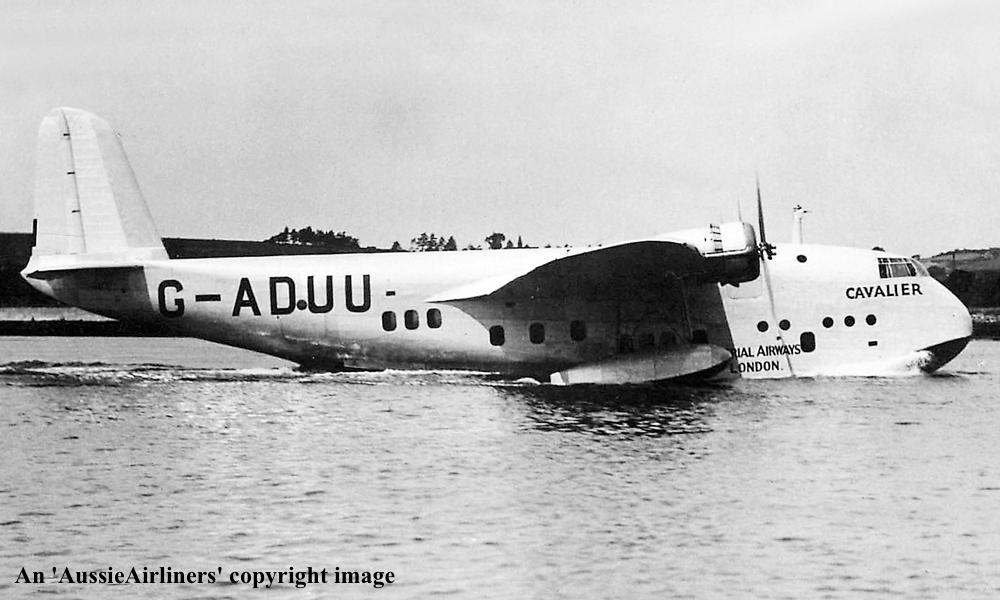 |
G-ADUU. Imperial Airways London - 'Cavalier' in the standard livery on The Medway, Rochester, date unknown. (P. Sheehan Collection Copyright Image 2545-890.) |
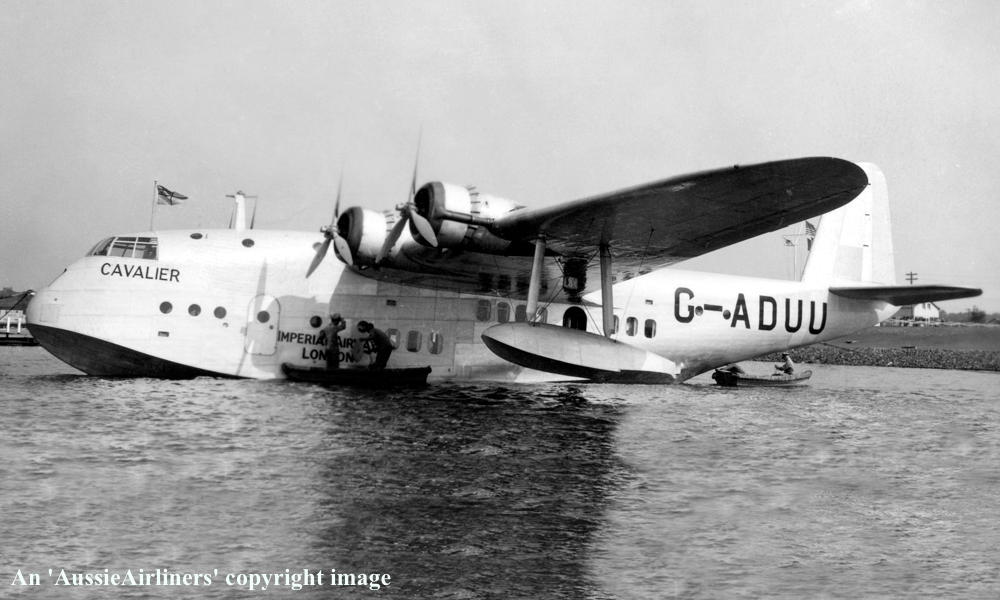 |
G-ADUU. Imperial Airways London - 'Cavalier' in the standard livery at an unknown location, date unknown. (A. J. Jackson Collection Copyright Image 2545-914.) |
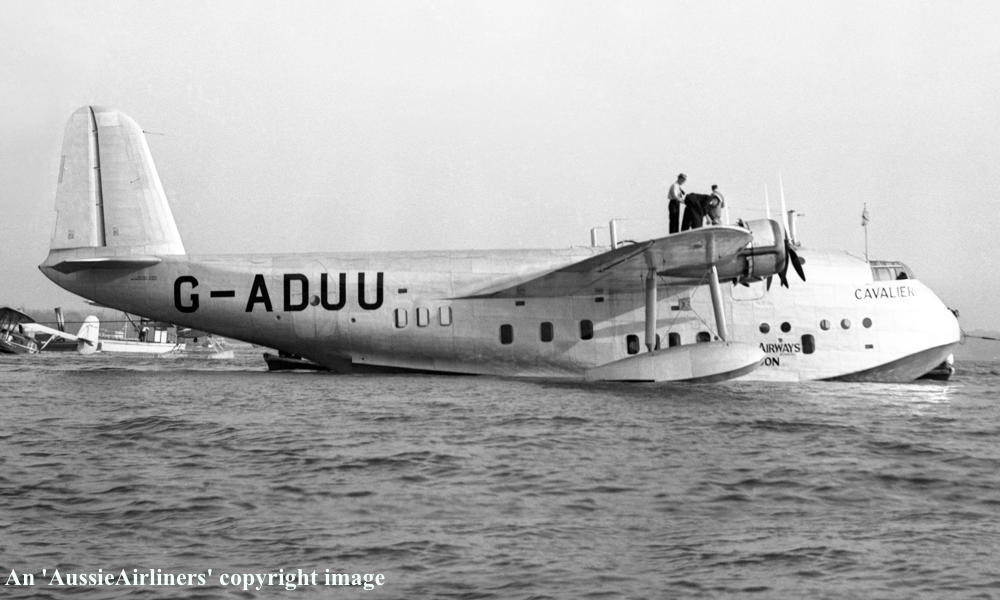 |
G-ADUU. Imperial Airways London - 'Cavalier' in the standard livery at an unknown location, date unknown. (A. J. Jackson Collection Copyright Image 2545-915.) |
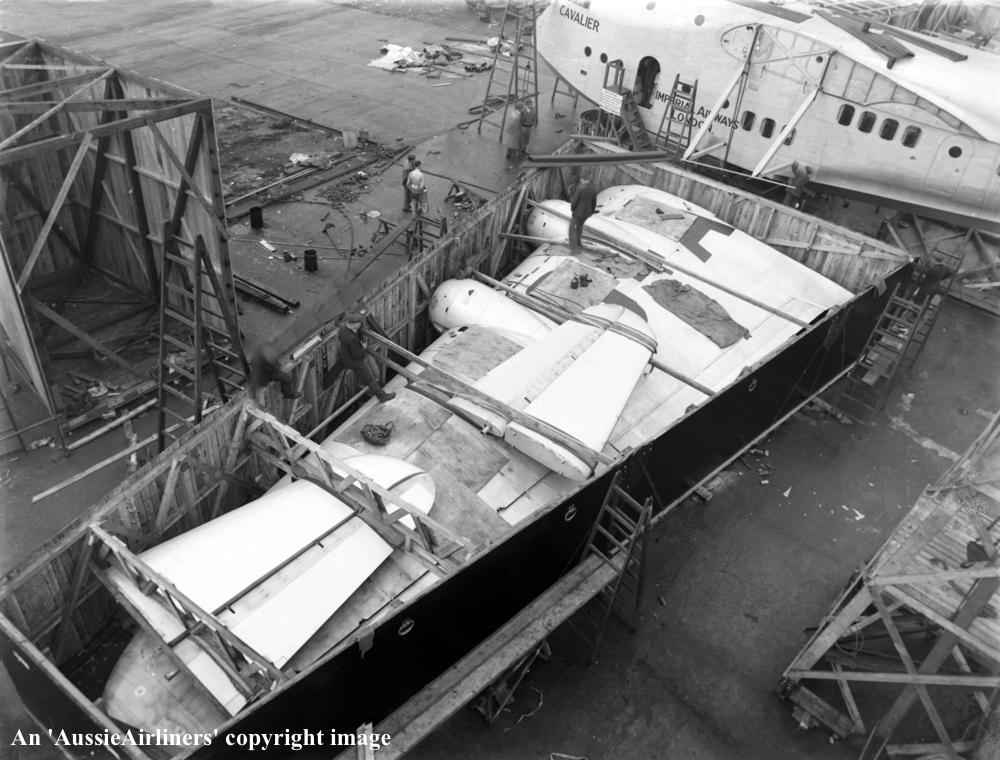 |
G-ADUU. Imperial Airways London - 'Cavalier' in the standard livery at Rochester, November 26, 1936. (P. Sheehan Collection Copyright Image 2545-893.) |
 |
G-ADUU. Imperial Airways London - 'Cavalier' in the standard livery at Rochester, November 30, 1936. The aircraft was being crated for transportation to Bermuda. (P. Sheehan Collection Copyright Image 2545-891.) |
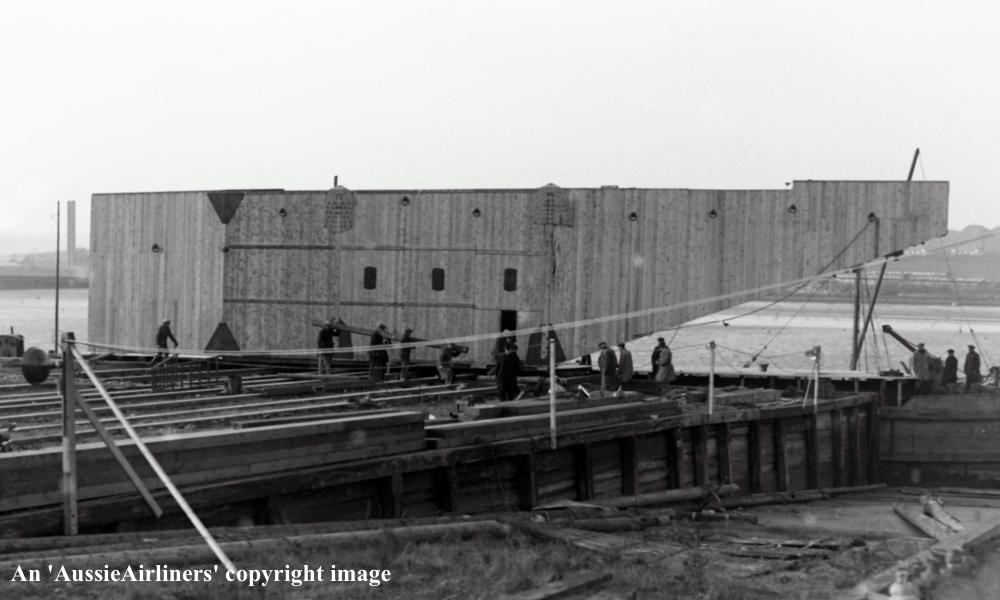 |
G-ADUU. Imperial Airways London - 'Cavalier' in the standard livery at Rochester, December 04, 1936. (P. Sheehan Collection Copyright Image 2545-892.) |
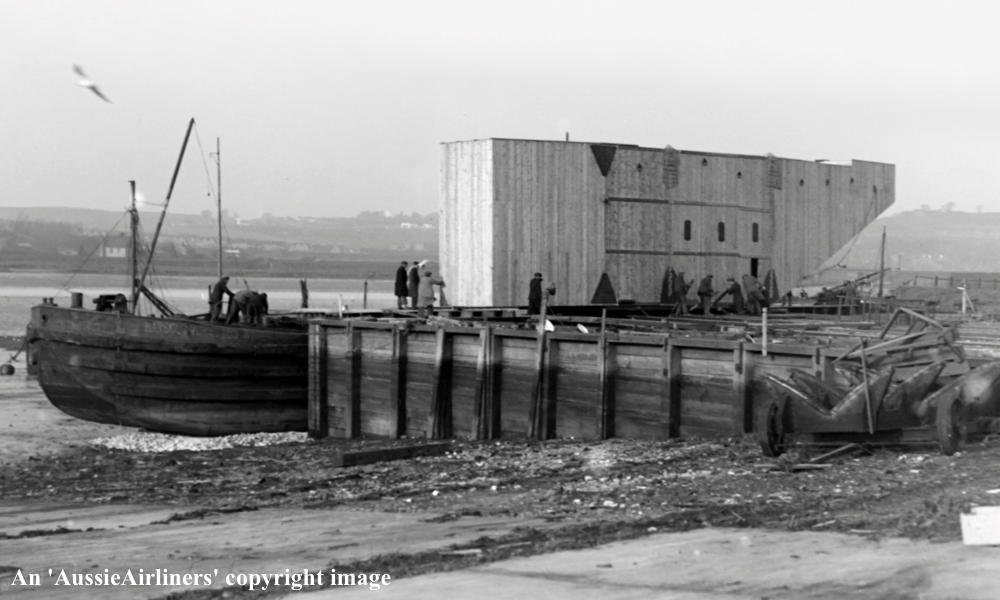 |
G-ADUU. Imperial Airways London - 'Cavalier' in the standard livery at Rochester, December 04, 1936. The crated hull loaded onto the barge for transportation. (P. Sheehan Collection Copyright Image 2545-899.) |
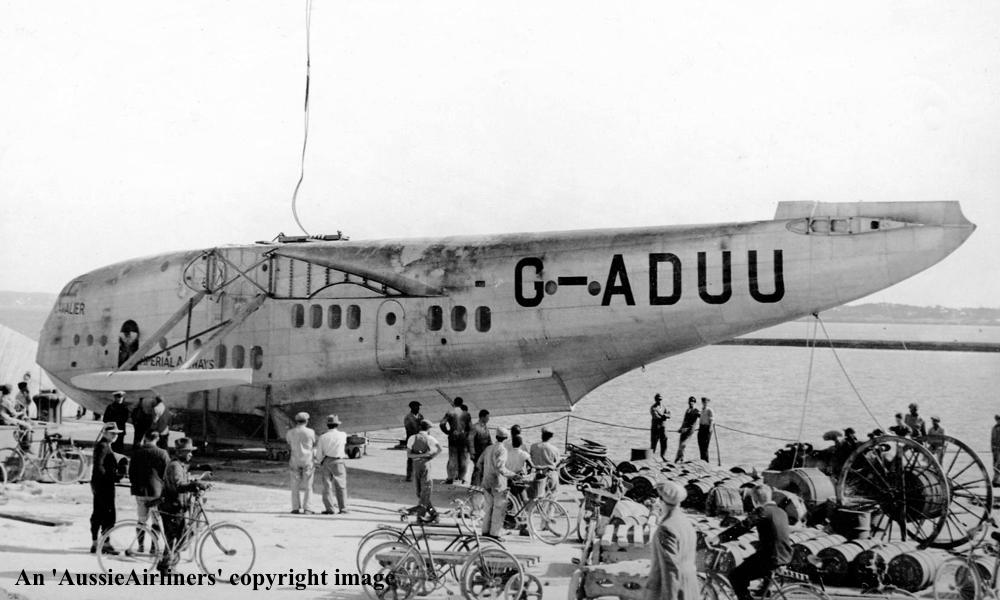 |
G-ADUU. Imperial Airways London - 'Cavalier' in the standard livery at Bermuda, December 30, 1936. (P. Sheehan Collection Copyright Image 2545-917.) |
 |
G-ADUU. Imperial Airways London - 'Cavalier' in the standard livery at Bermuda, December 30, 1936. (P. Sheehan Collection Copyright Image 2545-916.) |
 |
G-ADUU. Imperial Airways London - 'Cavalier' in the standard livery at Bermuda, February 1937. (P. Sheehan Collection Copyright Image 2545-894.) |
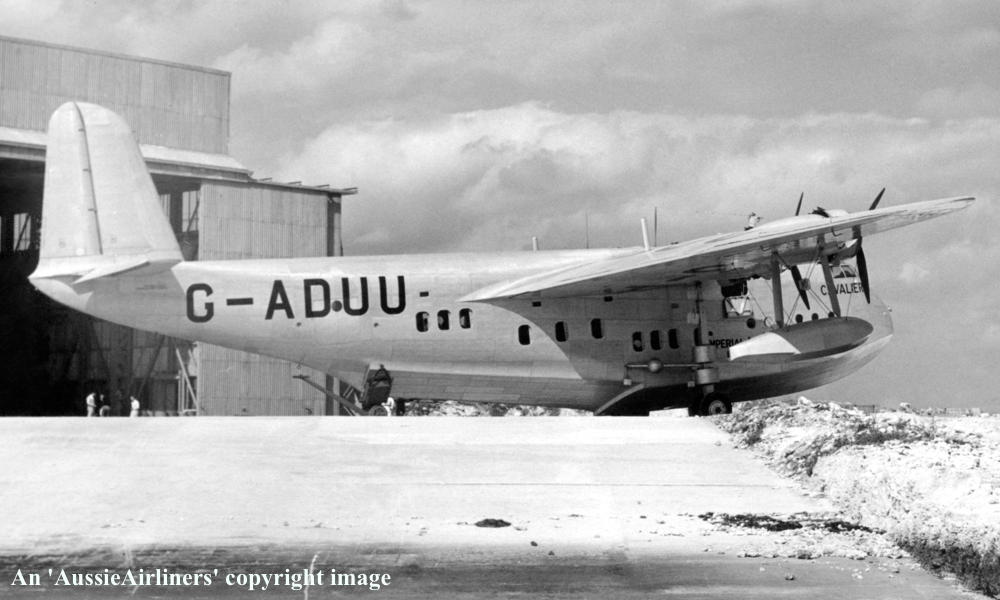 |
G-ADUU. Imperial Airways London - 'Cavalier' in the standard livery at Bermuda, February 1937. (A. J. Jackson Collection Copyright Image 2545-913.) |
 |
G-ADUU. Imperial Airways London - 'Cavalier' in the standard livery at an unknown location, circa 1937. (P. Sheehan Collection Copyright Image 2545-934.) |